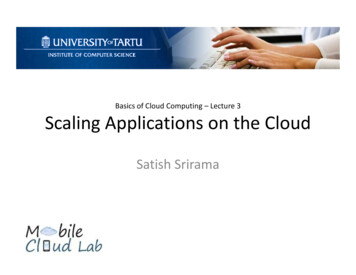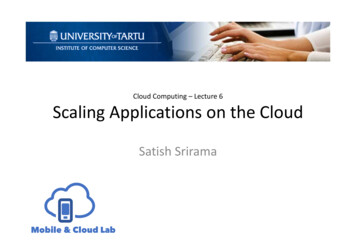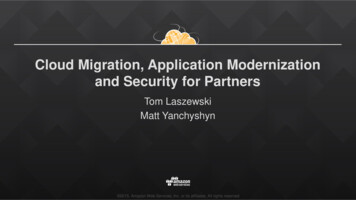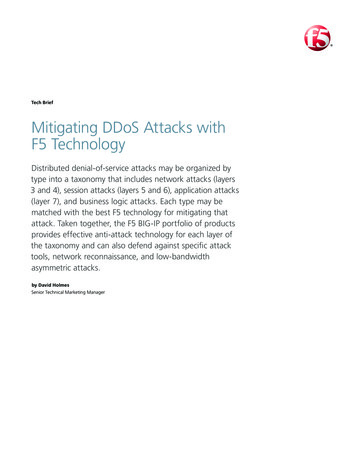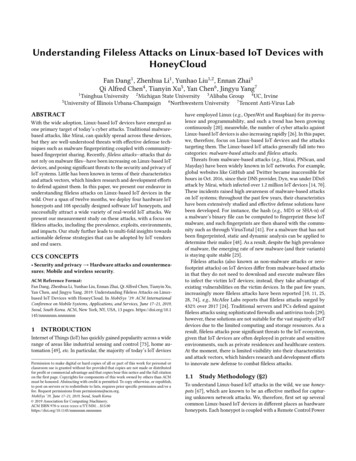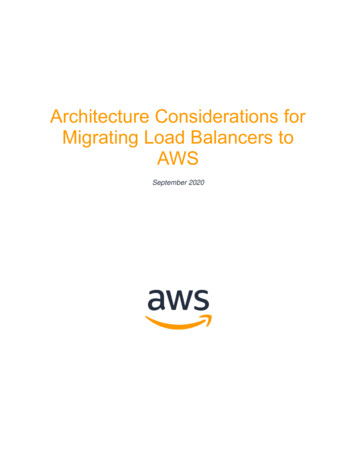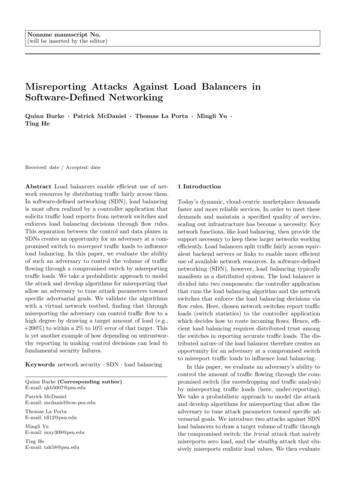
Transcription
Noname manuscript No.(will be inserted by the editor)Misreporting Attacks Against Load Balancers inSoftware-Defined NetworkingQuinn Burke · Patrick McDaniel · Thomas La Porta · Mingli Yu ·Ting HeReceived: date / Accepted: dateAbstract Load balancers enable efficient use of network resources by distributing traffic fairly across them.In software-defined networking (SDN), load balancingis most often realized by a controller application thatsolicits traffic load reports from network switches andenforces load balancing decisions through flow rules.This separation between the control and data planes inSDNs creates an opportunity for an adversary at a compromised switch to misreport traffic loads to influenceload balancing. In this paper, we evaluate the abilityof such an adversary to control the volume of trafficflowing through a compromised switch by misreportingtraffic loads. We take a probabilistic approach to modelthe attack and develop algorithms for misreporting thatallow an adversary to tune attack parameters towardspecific adversarial goals. We validate the algorithmswith a virtual network testbed, finding that throughmisreporting the adversary can control traffic flow to ahigh degree by drawing a target amount of load (e.g., 200%) to within a 2% to 10% error of that target. Thisis yet another example of how depending on untrustworthy reporting in making control decisions can lead tofundamental security failures.Keywords network security · SDN · load balancingQuinn Burke (Corresponding author)E-mail: qkb5007@psu.eduPatrick McDanielE-mail: mcdaniel@cse.psu.eduThomas La PortaE-mail: tfl12@psu.eduMingli YuE-mail: mxy309@psu.eduTing HeE-mail: tzh58@psu.edu1 IntroductionToday’s dynamic, cloud-centric marketplace demandsfaster and more reliable services. In order to meet thesedemands and maintain a specified quality of service,scaling out infrastructure has become a necessity. Keynetwork functions, like load balancing, then provide thesupport necessary to keep these larger networks workingefficiently. Load balancers split traffic fairly across equivalent backend servers or links to enable more efficientuse of available network resources. In software-definednetworking (SDN), however, load balancing typicallymanifests as a distributed system. The load balancer isdivided into two components: the controller applicationthat runs the load balancing algorithm and the networkswitches that enforce the load balancing decisions viaflow rules. Here, chosen network switches report trafficloads (switch statistics) to the controller applicationwhich decides how to route incoming flows. Hence, efficient load balancing requires distributed trust amongthe switches in reporting accurate traffic loads. The distributed nature of the load balancer therefore creates anopportunity for an adversary at a compromised switchto misreport traffic loads to influence load balancing.In this paper, we evaluate an adversary’s ability tocontrol the amount of traffic flowing through the compromised switch (for eavesdropping and traffic analysis)by misreporting traffic loads (here, under-reporting).We take a probabilistic approach to model the attackand develop algorithms for misreporting that allow theadversary to tune attack parameters toward specific adversarial goals. We introduce two attacks against SDNload balancers to draw a target volume of traffic throughthe compromised switch: the trivial attack that naivelymisreports zero load, and the stealthy attack that elusively misreports realistic load values. We then evaluate
2them against four widely used load balancing algorithms:least-loaded, weighted least-loaded, least-connections, andweighted least-connections, which are included in thewidely used Floodlight’s [2] and OpenDayLight’s [3]load balancing modules, and relied upon by several otherspecialized load balancing solutions [59,42,11,32,39,47].We note that most dynamic load balancers in practiceinevitably perform some form of least-X selection (e.g.,least-loaded in bytes, least-connections) to select themost suitable path or endpoint for a flow [43,31]. Thewide reliance on this calculation provides motivation forevaluating its effectiveness in a setting where the loadbalancer is subject to malicious inputs—in the form offalse load reports.Additionally, as the network traffic characteristicsdepend on the services offered by a subnetwork, we consider in our analyses two distinct traffic models thatare representative of workloads most commonly foundin modern cloud and datacenter networks: short andlong flows (in terms of flow duration) [14,49]. The adversary must therefore calibrate the attack parametersappropriately based on the environment. We validatethe attack algorithms with a virtual network testbed,finding that through misreporting the adversary cancontrol traffic flow to a high degree by drawing a targetamount of load (e.g., 200%) to within a 2% error ofthat target for short flows and within 10% error for longflows (with reduced error by using suggested alternativeattack strategies). Thus our attack model is an effectivetool for defensive analysis but also provides a means ofplanning attacks on real SDNs. This demonstrates thatmisreporting extends to other services beyond thosediscussed in prior work.This is yet another example of how depending on collecting faithful information from untrustworthy sourcesleads to vulnerabilities, the results here being potentiallydisastrous, besides being difficult to detect in real-time.Our key contributions are:– An attack model for analysis and planning of misreporting attacks against SDN-based load balancers.– Development of two attacks against SDN load balancers that allow an adversary to control the volumeof traffic through a compromised switch.– Evaluation of misreporting attacks against four widelyused load balancing algorithms and two distinct traffic patterns.Prior work has partially addressed the issue of compromised switches with regards to eavesdropping, message integrity, and malicious link-discovery messages [55,38,33]; however, they have not considered the effects ofmalicious control messages in the context of load balancing. Here, we evaluate the performance of SDN-baseddynamic load balancers in the presence of compromisedQuinn Burke et al.switches who may misreport traffic loads (by underreporting them). Several questions are raised concerningthe performance of dynamic load balancers in adversarial settings: (1) To what extent can an adversarydegrade the performance of load balancers by misreporting? (2) When must the adversary misreport? And (3),by how much must they misreport in order to accomplish their goal? We seek to address these key questionsto highlight and quantify adversarial capabilities withregards to critical SDN services such as load balancers.2 BackgroundSoftware-defined networks provide a framework thatallows a more reliable and scalable alternative to traditional hardware- and software-based load balancerswhich sit in front of network resources. In the following,we discuss how load balancing is typically realized inSDNs.2.1 Load-balancing AlgorithmsExisting load balancing solutions for traditional networks come in two categories: static and dynamic. Staticsolutions implement proactive techniques for splittingincoming flows evenly across network resources (i.e.,servers or links). Since the client mappings are knownahead of time, these techniques cannot exploit run-timeknowledge of bandwidth utilization, often resulting ina negative impact on network performance (e.g., underutilization, increased latency). Common implementations of static load balancing include Randomized,Round-Robin, and hash-based solutions like equal-costmultipath (ECMP) [11,37,54]. In contrast, dynamicsolutions implement various reactive techniques for connection assignment and provide a means for connectionaffinity by maintaining a per-connection state. Theyallow more flexible and favorable decision making byexploiting knowledge about resource utilization learnedduring normal operation of the network. Widely usedimplementations of dynamic load balancers include leastresponse-time, least-loaded, and least-connections, alongwith their weighted counterparts [42, 41, 61, 2].2.2 Load-balancing Architecture in SDNDedicated software-based load balancers offer scalabilityand reliability benefits over traditional hardware-basedload balancers, which are often expensive and suffer frompoor horizontal scalability [9]. Previous work has already
Misreporting Attacks Against Load Balancers in Software-Defined Networking3Load Reports over TimeL ad Bala ceCore LayerlleAggregation Layer(a)(a)Edge LayerServer FarmTo enable dynamic load balancing in SDNs, thenetwork administrator defines a pool : a set of switch portsconnected to (aggregation or edge/access) links whichare being balanced (see Figure 1). The load balancerthen requests traffic load reports from each pool memberat each time epoch t. We refer to the epoch length, thetime between load-report collections, as the collectioninterval, which may be one or more seconds long.Under the OpenFlow [4] protocol, the reports comein the form of switch statistics. The loads represent thetotal activity at the switch ports since the last report,and may be measured in terms of Kb, number of activeflows (or connections), etc., depending on the algorithmin use. The loads are then used by the controller toroute new incoming flows (that are destined for theresources offered by the pool) according to the loadbalancing algorithm; for example, with a variant ofleast-X selection. Note that end-hosts in general do notrun OpenFlow agents and therefore edge-switch load isinstead commonly used as a proxy for server load [39].4 Kb1 Kb7 Kb4 Kb1 Kb11 Kb8 Kb1 Kb12 Kb9 Kb6 Kb3 Kb12 Kb8 Kb6 Kb3 Kb13 Kb5 Kb2 Kb10 Kb7 Kb4 KbEpoch 1Epoch 2Epoch 3Epoch 4Epoch 5(2)(3)Time(Rti )Fig. 2 Load reportsused for routing new incoming flows.Bolded reports are where switches reported the minimum loadto the load balancer.member until the next load report is collected1 ; as theload balancer is removed from the data plane, it canonly respond to the information given in load reports.2.3 Notation for Load BalancingConsider a network composed of N pool members, wherethe load balancer requests a load report Rti at each timeepoch t for each member 1 i N . For the case ofleast-loaded and least-connections [42], the load balancertemporarily routes new flows through the member whoreported the minimum load (in bytes or number ofactive flows/connections), until the next load report iscollected. More formally, the new flows will be routedthrough some member m in epoch t if:Rtm min Rti ,1 i N(1)If multiple members report the minimum load, randomselection is done to choose between those members.For weighted least-loaded and weighted least-connections,an exponentially weighted moving average (EWMA [48])of loads is used for balancing. Weights are applied tothe historical load values (α, where 0 α 1) andthe current load value (1 α), which are then summedtogether to smooth out sudden bursts that may lead to0inefficient balancing. Then, the new load Rti computedfor each member at time t is:0As shown in Figure 2, when a switch reports theminimum load at any epoch, the load balancer will temporarily route new flows through it. For example, switch(3) reports 1Kb of activity in the first epoch, has newflows routed through it to a backend server or link, andreports 12Kb of activity in the following epoch. Importantly, in the general case of the considered algorithms,all incoming flows are routed through the same pool5 Kb(5)Server Farmdemonstrated the ability of load balancers to be implemented as software running on commodity hardware [28,44, 1]. In SDNs, however, load balancing typically manifests slightly differently. The load balancer is abstractedfrom the physical infrastructure by moving the loadbalancing logic to the control plane and distributingdecisions to network switches in the form of flow rules.7 Kb(4)(b)(b)Fig. 1 The SDN-based load balancing architecture showingthe pool members for balancing across (a) links or (b) servers.10 Kb(1)Pool membersC n0iRti αRt 1 (1 α)Rti ,(2)and new flows will be temporarily routed through themember with the minimum load as in (1), with Rtm and0Rti replaced by Rtm 0 and Rti . Again, random selection isapplied in the case of multiple members with the sameminimum value.1We leave to future work analyzing more specialized variants of these algorithms.
43 Attacking the Load BalancerMisreporting switch statistics allows adversaries to directly control the volume of traffic flowing through acompromised switch for larger-scale eavesdropping andtraffic analysis, which have been established as significant threats in modern cloud networks (e.g., to uncoverbrowsing histories [29]). Here, we introduce two attackmethods against SDN-based load balancers.3.1 Threat ModelWe assume switches report aggregate (i.e., port-level)statistics for themselves to a trusted load balancer, asbalancing is typically done at a coarser level than individual flows [12]. Of these switches, we assume that onebecomes compromised (to evaluate a lower bound onattacker capabilities, as several compromised switcheswould naturally allow an attacker to launch more sophisticated attacks). If the pool members are just theports on the compromised switch, then load balancingintegrity is clearly lost. We therefore consider the situation where ports on multiple edge switches form a pool 2and report for statistics for themselves (as edge switchload is commonly used as a proxy for server load [39]).We note that attacks against edge-switch-based loadbalancing are independent of the actual internal network structure (as the edge-load reports do not provideinsight on how load is to be distributed among internal links) and thus are not limited to just tree-baseddatacenter networks.Switches may be compromised by insider or externaladversaries [24,10,50,16]; while methods for compromising switches are outside the scope of this work, wenote that prior work has demonstrated how an adversarymay take control over a network switch—from exploitingweakly protected admin web interfaces to bugs in theswitch operating system software and hardware backdoors [52]. For example, many organizations leverageopen-source switch software such as Open vSwitch [45]and an adversary could fuzz the source code to identifyexploitable bugs such as a buffer overflows, from whichthey can achieve privilege escalation and thereafter assume administrator control over the switch [53].In the context of load balancing, we define the generaladversarial goal as drawing a large fraction of networktraffic to perform large-scale eavesdropping or denial-ofservice attacks. This would potentially enable the adversary to access sensitive control-plane messages (e.g.,2Note that switches may have multiple pool members(ports), but here we just consider a single pool member perswitch and use switch and pool member interchangeably.Quinn Burke et al.topology discovery messages) or sensitive client trafficin a multi-tenant datacenter network, besides causingavailability problems—which have been demonstrated tobe significant threats to SDNs [55,22,52]. The adversaryaccomplishes this by misreporting to induce the loadbalancer into sending a target volume of traffic (on average) through the compromised switch. The adversary’scapabilities are limited to recording its own load reportsand sending misreports. Note that misreporting is necessary to draw more traffic regardless of if packets onthe switch ports are actually dropped; nevertheless, theadversary may drop an equivalent amount of traffic toevade detection systems that may leverage downstreamswitches to find inconsistencies in reports. We focus onadversaries under-reporting their true load to obtainan unfairly large proportion of traffic. We note thatover-reporting loads may be useful for denying serviceto other switches in the pool, however, such an requiresa different attack formulation and therefore we defer itto future work (see Section 5).3.2 OverviewStudies of modern datacenter and cloud networks haveobserved that datacenter network traffic can be modeled by positive-skewed and heavy-tailed distributionsof network flow sizes and flow durations [14, 15, 49]. Forexample, the flow distribution may consist of a majorityof small (in bytes) and short (in seconds) flows thatexist in the network only for a few seconds. This trafficis representative of applications such as web servers. Incontrast, the flows may consist of a majority of relativelylonger and larger flows that persist in the network forseveral seconds or minutes, for example, for applications like video streaming. Importantly, our preliminaryobservations of these traffic patterns across a pool ofservers reveals a new threat vector for an adversaryto compromise the load balancer: since pool membersserve similar kinds of services, they observe similar traffic characteristics, which agrees with observations fromprior work [14]. Therefore, the adversary can use theirobserved behavior as an approximation for what otherswitches in the pool observe (see Fig. 3), and tune theirattack strategy to meet specific goals.In this context, in steady-state if the adversary reports the minimum load (i.e., “wins” the epoch) forX% of the time epochs, they will observe X% of thetotal load in the system—as they draw X% of the totalflows that arrive. In terms of load balancing fairness,we therefore formalize misreporting in terms of a target fraction of load in the system to draw through thecompromised switch (equivalently, a target fraction ofepochs to “win”). We will refer to this target as T . Note
Misreporting Attacks Against Load Balancers in Software-Defined Networking1.0Cumulative ember[9]Member[10]500 1000 1500 2000 2500 3000Load (Kb)Fig. 3 Distribution of load reports collected once per secondfrom switches in a 10-member load balancing pool over 10minutes. Load distributions show small differences betweenpool members, enabling an adversary to estimate the trafficcharacteristics at other switches using their own observations.that here the load in the system refers only to the clienttraffic destined for the pool. We then introduce twomisreporting attacks with respect to T . In the trivialattack, the adversary’s goal is to maximize the probability of winning the epoch each time a misreport issent by reporting a load of zero. In the stealthy attack,the adversary misreports to nonzero loads that stillhave a high probability of being the minimum amountreported, allowing them to reduce their likelihood ofbeing detected by an anomaly detection system whilestill obtaining the target load.The challenge here is determining the required frequency of misreports (denoted by M ) to draw the targetload (equivalently, to win the target fraction of epochs).The adversary must therefore calibrate δ, the misreported amount (in Kb or number of flows) sent to theload balancer. The choice of δ affects the misreportingsuccess probability (i.e., if the load balancer immediatelybegins routing new flows through the switch) and therefore the required frequency of misreports to accuratelydraw the target load.3.3 Attack ModelHere we introduce an attack model from which theadversary will derive attack parameters M and δ for agiven target T , generalizing the model introduced in ourprior work [19].3.3.1 Computing the Required Misreporting FrequencyThere are two components that determine the expectedprobability of winning an epoch: the probability of winning when not sending a misreport (reporting honestly)5and the probability of winning when sending a misreport. At epochs when the adversary reports honestly,our heuristic approach is to assume the adversary has afair chance, i.e., the probability of winning is 1/N .When misreporting, guaranteeing a 100% misreporting success rate is difficult unless simply sending a loadof zero in each misreport. However, sending a load ofzero in each misreport (i.e., the trivial attack) may likelyraise alarms, especially if the target load is very high(e.g., 75% of the load in the system) which will necessarily require misreporting more frequently. A moreelusive approach is for the adversary to simulate activityat the switch by misreporting (setting δ) to very lowloads which have been observed previously and whichhave probability of success comparable to sending a loadof zero. This is less likely to raise flags as it would bedifficult to discern a legitimate report from a falsifiedone.To this end, we approximate the load distributionobserved at other pool members by that observed by theadversary before the attack. Without loss of generality,we first denote the compromised switch by switch N .If we let p denote a cumulative probability of the loaddistribution (see Fig. 3), then there is an associatedload value pL (in Kb or number of flows) with thatcumulative probability: a p fraction of observed loadsfalls within [0, pL ]. If the adversary simulates activityat the port by misreporting to random loads within thebottom pth percentile of previously observed loads (e.g.,the bottom 10th percentile loads), then the probability(approximately) of all other switches reporting a loadvalue higher than the adversary can be estimated as:\Pr[(Rti RtN )] (1 p)(N 1) .(3)i6 NNote that if the adversary has knowledge of the sizeof the load balancing pool, they can directly evaluate theexpression. However, if they do not, they can estimateit based on their own load reports. If we denote thesteady-state load in the system by L, the adversarycan compute from their own load reports the averageflow duration of t epochs, arrival rate of R flows atwinning epochs, and average flow rate of b bps. Then,they can compute the steady-state load in the systemas: L t R b. If under normal conditions, each poolmember observes approximately a fair share S L/Nload, then the adversary can estimate the pool size bydividing their fair share by the computed load in thesystem: N L/S. Other methods for estimating poolsize may leverage known techniques to map the loadbalancing pool in SDNs (or the network in general),such as probing the subnets identified in flow rules orlistening for ARP packets [6, 35].
6Quinn Burke et al.Table 1 Parameter descriptions for the attack model.ParamNTpMδWRtiDescriptionNumber of pool membersTarget fraction of load in the systemMisreporting load upper thresholdMisreporting frequencyChosen misreported loadAttack length (in epochs)Load report for member 1 i N at time tAt a misreporting frequency of M , we use the twoprobabilities compute the expected fraction of load inthe system to observe at any epoch during the attack(or equivalently, the expected winning probability):E[load] 1/N (1 M ) (1 p)(N 1) M.T 1/N.(1 p)(N 1) 1/N3.4.2 Stealthy Attack(4)For the expected load to be the target load in the systemT , we can rearrange Eq. (4) to solve for the requiredmisreporting frequency M (where 0 M 1) for thetarget:M p 0, which corresponds in general to a load of zero (asswitches generally always observe some background traf00fic), and thus the adversary will send a new load RtN in00each misreport: RtN δ 0. They will then computethe required misreporting frequency from Eq. (5) andbegin sending the misreports with zero load. Note thatmisreports can be sent at a fixed period 1/M or at random epochs during the attack with an average periodof 1/M . Moreover, the choice of a smaller p requiresa smaller misreporting frequency, which is generallybeneficial, however, consistent reports of zero load maybecome readily observable.(5)We further denote the attack window as W epochs long(e.g., from time epochs 500-1000), and can compute theactual number of misreports sent as the product: M W .We provide parameter descriptions in Table 1.3.3.2 Selecting a Load ValueThe adversary will then randomly set δ to a previouslyobserved load in [0, pL ] for each misreport, to achievethe expected winning probability. Note that it is up tothe attacker to assess the environment and decide whatan appropriate undetectable load would be, i.e., howmuch load can they misreport before they are observableto some detection system. Thus, what we provide hereis a method for configuring the attack such that theadversary can target a specific load (to within reasonablebounds) that they have decided as stealthy.In this attack, the adversary relaxes the load valuesto which they misreport to (i.e., δ) in order to manage their detectability. After assessing the environmentto determine an appropriate threshold p, the first stepis to perform reconnaissance for a configurable periodof time (e.g., 600 seconds, or 10 minutes), from whichthey record their load observations and prepare to sendmisreports. Note that they may also estimate the poolsize during reconnaissance if necessary, as discussed inSection 3.3. The adversary will select an appropriate00load for each misreport: RtN δ, where δ [0, pL ].After the reconnaissance period is complete, the adversary computes the required misreporting frequencyfrom Eq. (5) and begins sending the misreports withan appropriate load value. Here, misreports can also besent at a fixed period 1/M or at random epochs duringthe attack with an average period of 1/M . Further, thechoice of a smaller p will result in a higher misreportingsuccess probability and therefore require a smaller misreporting frequency. The inverse is also true, which leadsto limited parameter flexibility for the stealthy attack.Thus, there is a natural tradeoff between misreportingsuccess and detectability (discussed in Section 4).3.5 Assessing the Impact3.4 Launching the AttackIn this section, we present two attack strategies for theadversary to draw the target load through the switchport: the trivial attack and the stealthy attack.3.4.1 Trivial AttackIn this attack, the goal of the adversary is to maximize the winning probability under a given target. Tomaximize the probability that the misreported load willbe the minimum in Eq. (1), the adversary will selectTo assess the effects of the proposed attacks, we firstwant to measure the direct impact of misreporting. Wethen evaluate the bounds on attacker capabilities underboth the trivial and stealthy attacks to understand theextent to which an adversary can cause imbalance inthe load balancing pool.3.5.1 Attack EffectivenessTo describe the direct impact of the attack with regardsto drawing more traffic through the switch, we define
Misreporting Attacks Against Load Balancers in Software-Defined Networkinga damage metric D. It represents the ratio of the average load on the compromised switch during the attackwindow to the average load observed under normal conditions. If we denote the average load during the attackby La , and under normal conditions by Ln , then therelative damage is:D La 1.Ln(6)To concretely quantify misreporting effectiveness, weintroduce a potency metric P that represents the ratioof damage per percent of misreported epochs:P D.M(7)We also measure the frequency, as well as the successrate of misreporting, which describes how often a misreport resulted in more traffic being routed through thecompromised switch.3.5.2 Capturing Victim TrafficAs the general adversarial goal is to draw more trafficon which to eavesdrop, we also discuss the success ofour attack in the context of an adversary targeting aspecific flow (or traffic type) that they have knowledge ofexistence (e.g., they know users are currently browsinga specific website). If an X% proportion of the loadin the system (in number of flows or bits) is passingthrough the switch, then an equivalent description isthat the adversary has an X% chance of capturing avictim flow. We therefore assess the ability to capturevictim traffic by analyzing the flexibility in parameterchoice under a given target load and the bounds onadversary capabilities under both attack strategies.74.1 Experimental Setup4.1.1 Network setupFor experimentation, we employ the latest version ofthe widely used Floodlight [2] SDN controller, alongwith its load balancing module. To configure the virtualnetwork, we use the popular Mininet emulator [25] tocreate a similar topology of virtual switches and hosts tothat shown in Figure 1. New flows will originate from asource connected to the “top-most” switch in the figure,which represents a common gateway from which flowssplit paths in the network (e.g., an aggregation switchin a three-tiered network). Each switch runs the latestversion of Open vSwitch (v2.12.0) and is invoked toconnect to and receive forwarding instructions from theFloodlight controller. The directly connected hosts actas sinks for the incoming network flows. The attacksare then carried out by designating one switch as theadversary.We configure the load balancer to have a singlepool consisting of 10 SDN-enabled switches, which is arealistic pool size for small clusters based on real configurations used in the wild [46]. We note that our experimentation with larger pool sizes yielded qualitativelysimilar results, where the load is scaled proportionately.The switches are directly connected to a single backendresource (which can represent either servers, or moreswitches). We also configure the load balancer to have aload-report collection period of 1 second, which is suitable for providing reasonably low load-error rates [12, 30,23]. We set the attack window to W 300 epochs, andwe set the misreporting percentile to p 0.01 for thestealthy attack and p 0.0 for the trivial attack. Simulations are averaged over 10 independent executions.Without loss of generality, the adversary is designatedby switch number N .4.1.2 Traffic models4 EvaluationWith the formulation of the at
run OpenFlow agents and therefore edge-switch load is instead commonly used as a proxy for server load [39]. As shown in Figure 2, when a switch reports the minimum load at any epoch, the load balancer will tem-porarily route new ows through it. For example, switch (3) reports 1Kb of activity in the rst epoch, has new

